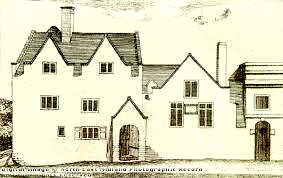I was talking last time about a book which I have started writing about the High School’s war dead from World War 2. At the moment, the book has no title but that will emerge!
I intend to incorporate a few poems in the book. You will be glad to hear that none of them are by me.
One comes from the writings of ‘Granta’ in the School Magazine, The Nottinghamian. To paraphrase his words:
Nine Nottinghamians,
At the Forest Road gate,
One went to Bomber Command,
And then there were eight.
And the poem by John Maxwell Edmonds:
Went the day well ?
We died and never knew.
But, well or ill,
Freedom, we died for you.
This poem was written by R. W. Gilbert and was featured by my friend Pierre Lagacé in his blog « RCAF 425 Les Alouettes »
REQUIEM FOR AN AIR GUNNER.
The pain has stopped, for I am dead,
My time on earth is done.
But in a hundred years from now
I’ll still be twenty-one.My brief, sweet life is over
My eyes no longer see,
No summer walks, no Christmas trees,
No pretty girls for me.
I’ve got the chop, I’ve had it.
My nightly ops are done.
Yet in another hundred years
I’ll still be twenty-one.
I may incorporate a poem by a Bomber Command veteran, John Pudney:
“Do not despair
For Johnny-head-in-air;
He sleeps as sound
As Johnny underground.
Fetch out no shroud
For Johnny-in-the-cloud;
And keep your tears
For him in after years.
Better by far
For Johnny-the-bright-star,
To keep your head,
And see his children fed.”
I have not decided yet on which ones I will definitely use, except for the following words which will certainly appear. They describe perfectly the job that, hopefully, I will have done. They were written by (possibly Robert) Wace, a Norman poet who was born in Jersey in the Channel Islands between 1099 and 1111 and who was last known to be alive in 1174. Wace was brought up in Caen in Normandy and eventually became Canon of Bayeux:
Eventually
All things decline
Everything falters, dies and ends
Towers cave in, walls collapse
Roses wither, horses stumble
Cloth grows old, men expire
Iron rusts and timber rots away
Nothing made by hand will last
I understand the truth
That all must die, both clerk and lay
And the fame of men now dead
Will quickly be forgotten
Unless the clerk takes up his pen
And brings their deeds to life again.
In Jersey’s Royal Square stands the States Building and a granite memorial stone to Wace is built into one of its side walls:
It has on it a proud quote from Wace’s major work, the Roman de Rou, the Tale of Rou, which tells the story of William the Conqueror and the Norman Conquest, including Halley’s Comet :
Jo di e dirai ke jo sui
Wace de l’isle de Gersui
In Modern French it would be
Je dis et dirai que je suis
Wace de l’île de Jersey
And in English
I say and will say that I am
Wace from the Island of Jersey
It is also recorded in Modern Jèrriais, a language I had never heard of, but it still has an admittedly declining number of speakers on the island :
J’dis et dithai qu’jé sis
Wace dé l’Île dé Jèrri
It was Wace who introduced the idea of Halley’s Comet to the Bayeux Tapestry story:
Watch what you’re doing with that arrow !!!! You’ll take somebody’s eye out !!!!
Because I am a registered Nerd / parce que Je suis un geek de la langue française, I have the poem in Modern French and whatever language Wace spoke as well…Norman, Medieval French, Medieval Jèrriais, whatever. In the first section I have put ye Olde Frenche firste, and then modern French in Italics and then English. In the second section, see if you can think of the modern French words that ye Olde Frenche comethe fromme ….
Tote rien se tome en declin
Tout décline
All things declineTot chiet, tot muert, tot vait a fin
Tout meurt, tout va à fin
Everything falters, dies and endsHom muert, fer use, fust pourrist
L’homme meurt, le fer use, le bois pourrit
Men expire, iron rusts and timber rots awayTur font, mur chiet, rose flaistrit
la tour s’écroule, le mur tombe, la rose flétrit
Towers cave in, walls collapse, roses wither,cheval tresbuche, drap viesist
cheval bronche, drap vieillit
horses stumble, cloth grows old,Tot ovre fet od mainz perist
tout ce qui est fait de la main des hommes périt
Nothing made by hand will last
………………………………………..Bien entenz è conoiz è sai,
I hear the truth well and I am aware and I knowKe tuit morront è cler è lai;
That all must die, both clerk and layE mult ara lor renomée
Emprez lor mort corte duréeAnd the fame of men now dead
Will quickly be forgottenSe par cler ne est mise en livre,
Unless the clerk takes up his penNe pot par el durer ne vivre
And brings their deeds to life again.Wace, Romain de Rou, III, II, 131-142
(c 1170)
The translation is not such a close fit in the second bit rather than the first.
































